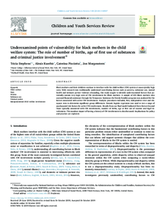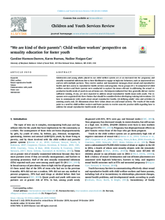Displaying 841 - 850 of 2215
The purpose of this study was to explore the experiences foster alumni college students (i.e., students who, as adolescents, were in foster care or other out-of-home conditions) considered pertinent during their first year in college.
With research into traditionally understood contributing factors such as poverty, substance use, mental health and intimate partner violence abounding, this study sought to identify underexamined factors that potentially sustain very high rates of child welfare (CW) involvement for Black mothers.
The purpose of this qualitative study was to understand the extent to which the core tenets of attachment, identity, self-efficacy, and critical race theories collectively explain or validate experiences of school engagement and academic outcomes among pregnant and parenting teens in the child welfare system.
The purpose of this systematic review was to examine the type, format and content/competencies of published foster parent preservice training, study characteristics of published preservice training research, and the methodological characteristics and primary findings of published foster parent preservice training research.
In this study, focus groups comprised of child welfare workers and foster parents were conducted to capture the issues relevant to addressing the sexual reproductive health needs of youth in out-of-home care.
In this article for the Chronicle of Social Change, Joette Katz - the former commissioner of the Connecticut Department of Children and Families - describes how the U.S. state of Connecticut's child welfare agency moved from a culture of "that emphasized 'beds' and 'placements' to one that sought the right treatment in the family home or at least in the home of a relative or foster family."
In this article, the stories of children left-behind by parental migration in Central America and Mexico are conveyed in their own words detailing how vulnerable they felt when abandoned, confused, and at times, rejected after finally connecting with their long-lost families.
The literature examining reunification for American Indian children reveals mixed findings regarding racial differences. Studies that isolate the impact of race on reunification while controlling for other covariates are needed, and this study fills that gap.
This article from the Washington Post tells the story of family separation due to the opioid epidemic in the U.S. state of West Virginia.
ISS-USA announced their 7th Annual Conference, Beyond Separation: Protecting Cross Border Families, co-hosted by the University of Maryland School of Social Work from Thursday, October 17th through Friday, October 18th.



